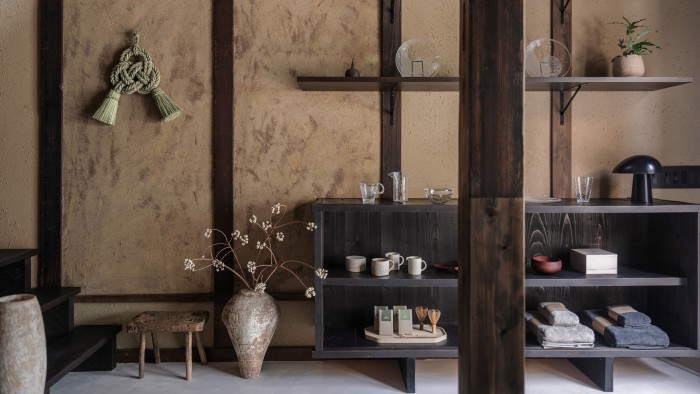Unlock the Editor’s Digest for free
Roula Khalaf, Editor of the FT, selects her favourite stories in this weekly newsletter.
It’s said that Sofia Coppola’s Lost in Translation (2003) is a Japanese film. Not because it’s set in Tokyo (and briefly Kyoto), but because it immerses the viewer in ambiguity. From the opening shots of Scarlett Johansson’s pastel-clad bottom to the denouement whisper, unheard, between her and Bill Murray, the film is visually mesmerising but narratively elusive. I rewatched it, glass of duty-free sake in hand, after a three-week sojourn in Japan with my 10-year-old son. It occurred to me that I’d got Japan all wrong.
What we, with western eyes, perceive as confusing, the Japanese simply accept as coexistence. The ancient Shinto shrines next to flashing billboards: why not? An upbeat orange fairy as the mascot of the Tokyo Police: of course. And every cityscape marred by a tangle of overhead wires because Japan, regardless of its technological prowess, does not bury its cables: hai!
Our trip took us from Tokyo to Hiroshima via Kyoto, Osaka and Nara, and everywhere we encountered contradictions: incredible ¥100 shops (just 50p for almost anything you can imagine!), temples of designer delight, a decades-old ramen shop, raucous neon karaoke bars, the futuristic Shinkansen bullet trains, and fax machines. Yet despite these apparent clashes, Japan’s deep-rooted appreciation for aesthetics and craftsmanship is undeniable. Certainly this is what draws me to the country. I went this time with no prescribed agenda apart from a desire to seek out the relatively new Kyoto-based design studio Pieces of Japan.
Its founder, Tina Koyama, embodies Japan’s “contradictions”. As she puts it: “I grew up in Switzerland, where many people couldn’t tell the difference between China and Japan.” After a career in design and digital tech that took her to Silicon Valley, she returned to her roots with the mission to create a “bridge between worlds: Japan’s artisans and the west.” Think pared-back stools exquisitely crafted from local hinoki wood and paper cord, or elegant Shigaraki tableware that uses clay from one of Japan’s “six ancient kilns” – ceramic production areas designated as heritage sites in Echizen, Seto, Tokoname, Shigaraki, Tamba and Bizen.
Indeed, what generally distinguishes Japanese craft from that of other countries is precisely this apparent anomaly, an imbued respect for nature and centuries of history overlaid by irreverence. The culture thrives on paradox and evolution, seamlessly blending past and present, tradition and innovation, restraint and indulgence – where these forces meet is where the magic happens.
My theory is that such an approach originates with the traditional script, kanji, based on Chinese characters that found their way to Japan around AD700. There are 2,136 “standard-use kanji” and Japanese children must start to learn them from primary school alongside about 10,000 vocabulary words. Everywhere you walk in Japan you are surrounded by these artful, expressive strokes, incomprehensible to foreigners unless, like my son, you are armed with a Beginner’s Guide that helps decipher them as pictograms. For the creatively minded, surely these characters fire different synapses in the brain to those routinely activated in the west?
I put this theory to Koyama. “I imagine its layered meanings encourage a way of thinking that moves beyond the literal,” she says. “The act of writing itself requires focus and deliberation. Watching my kids, I see it helps develop fine motor skills from a young age, which I feel translates into a heightened sense of craftsmanship.”
Furthermore, the fluidity of the Japanese language encourages a way of thinking that fully embraces ambiguity. Kabuki, for example, the traditional form of theatre, relies on dramatic leaps of logic. As writer Pico Iyer observes in A Beginner’s Guide to Japan: “In Japan, studied vagueness is not about diffidence but allowing room for someone else to turn an opening note into a duet.” That someone, potentially, being you.
Japan refuses to conform to western binaries. Things are rarely either/or – more often both. Viewed from this perspective, could Nintendo have originated anywhere other than Kyoto, home of the Geisha? Could the culture that requests phones be muted and conversations hushed on trains out of respect for other passengers also celebrate the deafening chaos of Pachinko parlours? Could master craftspeople interpret Pokémon for an exhibition in a shopping centre? The answer is always yes, because in Japan, contradictions are not opposing forces – they are complementary elements of a greater whole. In this way, Japan invites your participation rather than observation. It’s why Lost in Translation resonates so deeply. The film does not offer clear resolutions, rather it asks the viewer – like the reader or visitor – to embrace the unknown. And in so doing, it allows space for interpretation, for the endless fascination that draws so many to return. I’m already planning our next visit.
Read the full article here

